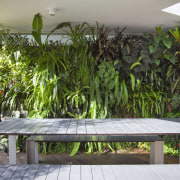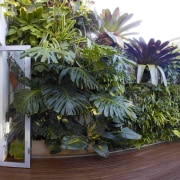What you need to know about greening your home
The pros and cons of the various options of greenwalls and greenroofs available today. Some are living, others are not – and one selection is a potential fire hazard!
By Mark Paul, founder of The Greenwall Company
When selecting the best option for greening your home, the first thing you need to consider is what look and feel you are trying to achieve.
Then you should engage an expert to assess the best planting options, irrigation set up, light access and the environment the wall or roof will be installed. Working with a horticulturist and an experienced designer, will ensure your installation lasts the lifetime of the home and in most cases can be moved with you.
Here are the pros and cons for the various options of greenwalls and greenroofs available today:
Living Greenwalls and Greenroofs
These installations are soilless and actively grow all year round. They require consistent light, food and water, plus an adequate surface area of the root zone exposed to air movement.
If planted correctly and set up with an automated irrigation system, they should require minimal maintenance and will flourish all year round.
Potted Plant Walls
This is more of a DIY greenwall, which is essentially a large number of potted plants that are formed to make a design. These walls require constant maintenance with most experiencing ongoing water issues due to a dripper blocking, which results in that particular pot dying and needing replanting.
Also, as soil is biodegradable it needs to be replaced frequently. These walls may by cheaper to install initially, but the costs really add up in maintenance, replanting and re-soiling each pot, not to mention the time.
Moss Walls
Contrary to popular belief, these walls are actually not living!
The moss is sourced from the arctic circle, coated, glued and sprayed with acrylic colours.
As a result, moss walls do not provide any of the environmental, health and wellbeing benefits to having living plants in the home.
On the pros, they are generally very cheap to install and are good collectors of dust and fibres.
Artificial Walls
Made from plastics, these fake walls are a quick fix to provide the appearance of greenery in a space and only require some dusting on a regular basis.
As they are made of plastics, unfortunately artificial walls actually do more harm to the environment than good due to the production.
On another note, the artificial walls collect fibres and dust, which means artificial walls are a fire hazard in the home.
Dust builds up and static electricity is generated from walking across synthetic carpet, which has resulted in a number of cases where the plastic walls become highly flammable.
....................................................
About The Greenwall Company:
The Greenwall Company is the premier producer of modular and custom designed greenwalls in Australia. Greenwall can be used like cladding to produce instant ‘greenspace’ both inside and out.
The system developed by Mark Paul at The Greenwall Company over approximately 30 years, presents an innovative system based on inorganic media and adjustable substrate depth that retains moisture and simulates conditions resembling natural soil.
In addition, by using plants adapted to impoverished environments and seasonal drought, The Greenwall Company achieves water efficient planting that is resilient to inevitable short-term human and mechanical failures. www.greenwall.com.au
Story by: Trendsideas
Home kitchen bathroom commercial design








